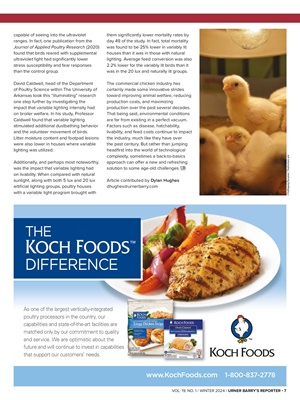
VOL. 19, NO. 1 / WINTER 2024 / URNER BARRY'S REPORTER • 7
www.KochFoods.com 1-800-837-2778
THE
KOCH FOODS
™
DIFFERENCE
As one of the largest vertically-integrated
poultry processors in the country, our
capabilities and state-of-the-art facilities are
matched only by our commitment to quality
and service. We are optimistic about the
future and will continue to invest in capabilities
that support our customers' needs.
capable of seeing into the ultraviolet
ranges. In fact, one publication from the
Journal of Applied Poultry Research (2020)
found that birds reared with supplemental
ultraviolet light had significantly lower
stress susceptibility and fear responses
than the control group.
David Caldwell, head of the Department
of Poultry Science within The University of
Arkansas took this "illuminating" research
one step further by investigating the
impact that variable lighting intensity had
on broiler welfare. In his study, Professor
Caldwell found that variable lighting
stimulated additional dustbathing behavior
and the volunteer movement of birds.
Litter moisture content and footpad lesions
were also lower in houses where variable
lighting was utilized.
Additionally, and perhaps most noteworthy,
was the impact that variable lighting had
on livability. When compared with natural
sunlight, along with both 5 lux and 20 lux
artificial lighting groups, poultry houses
with a variable light program brought with
them significantly lower mortality rates by
day 49 of the study. In fact, total mortality
was found to be 25% lower in variably lit
houses than it was in those with natural
lighting. Average feed conversion was also
2.2% lower for the variably lit birds than it
was in the 20 lux and naturally lit groups.
The commercial chicken industry has
certainly made some innovative strides
toward improving animal welfare, reducing
production costs, and maximizing
production over the past several decades.
That being said, environmental conditions
are far from existing in a perfect vacuum.
Factors such as disease, hatchability,
livability, and feed costs continue to impact
the industry, much like they have over
the past century. But rather than jumping
headfirst into the world of technological
complexity, sometimes a back-to-basics
approach can offer a new and refreshing
<
dhughes@urnerbarry.com-old challenges.
Article contributed by Dylan Hughes
dhughes@urnerbarry.com
©Yutthapong Rassamee / Shutterstock.com